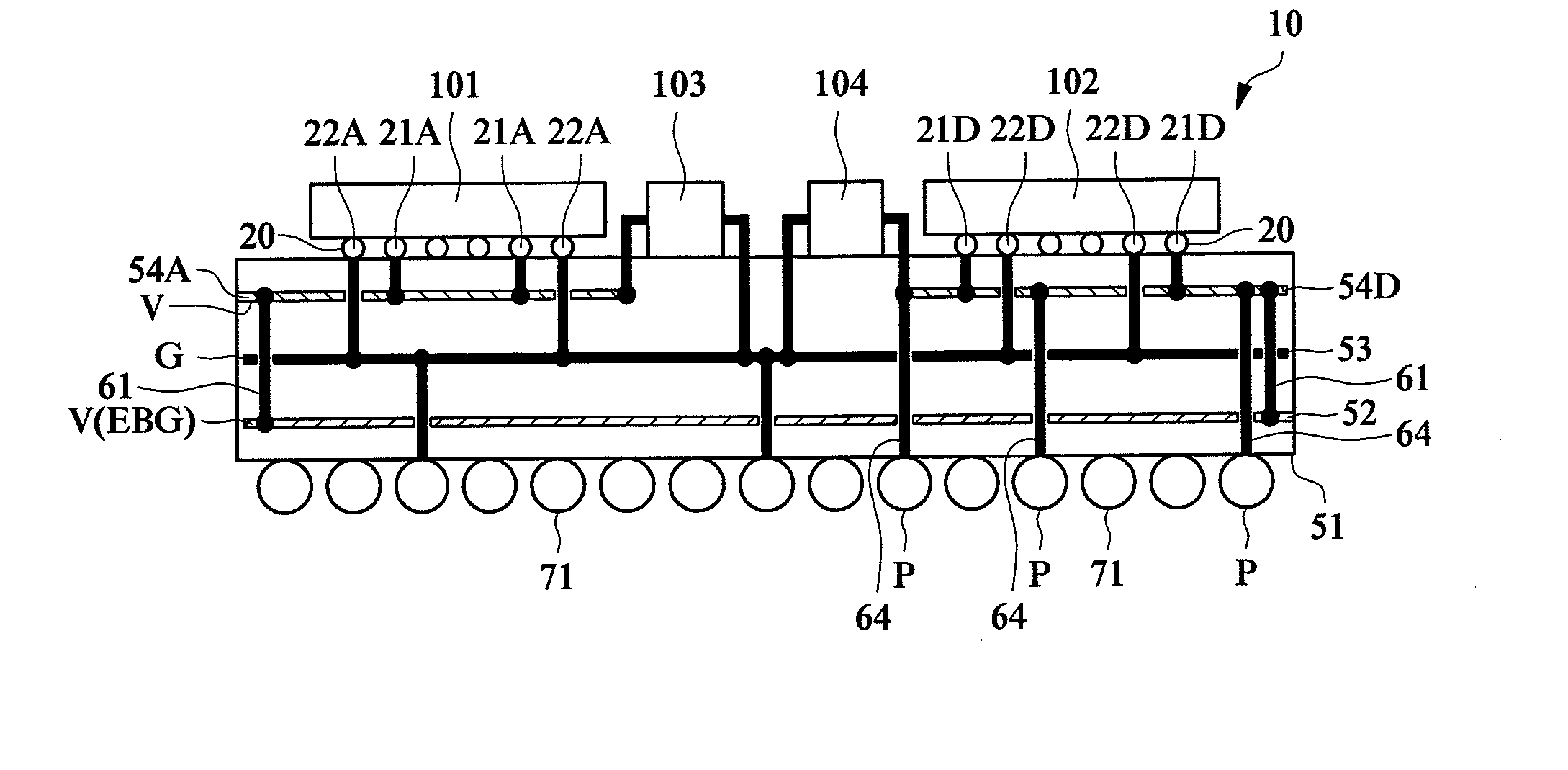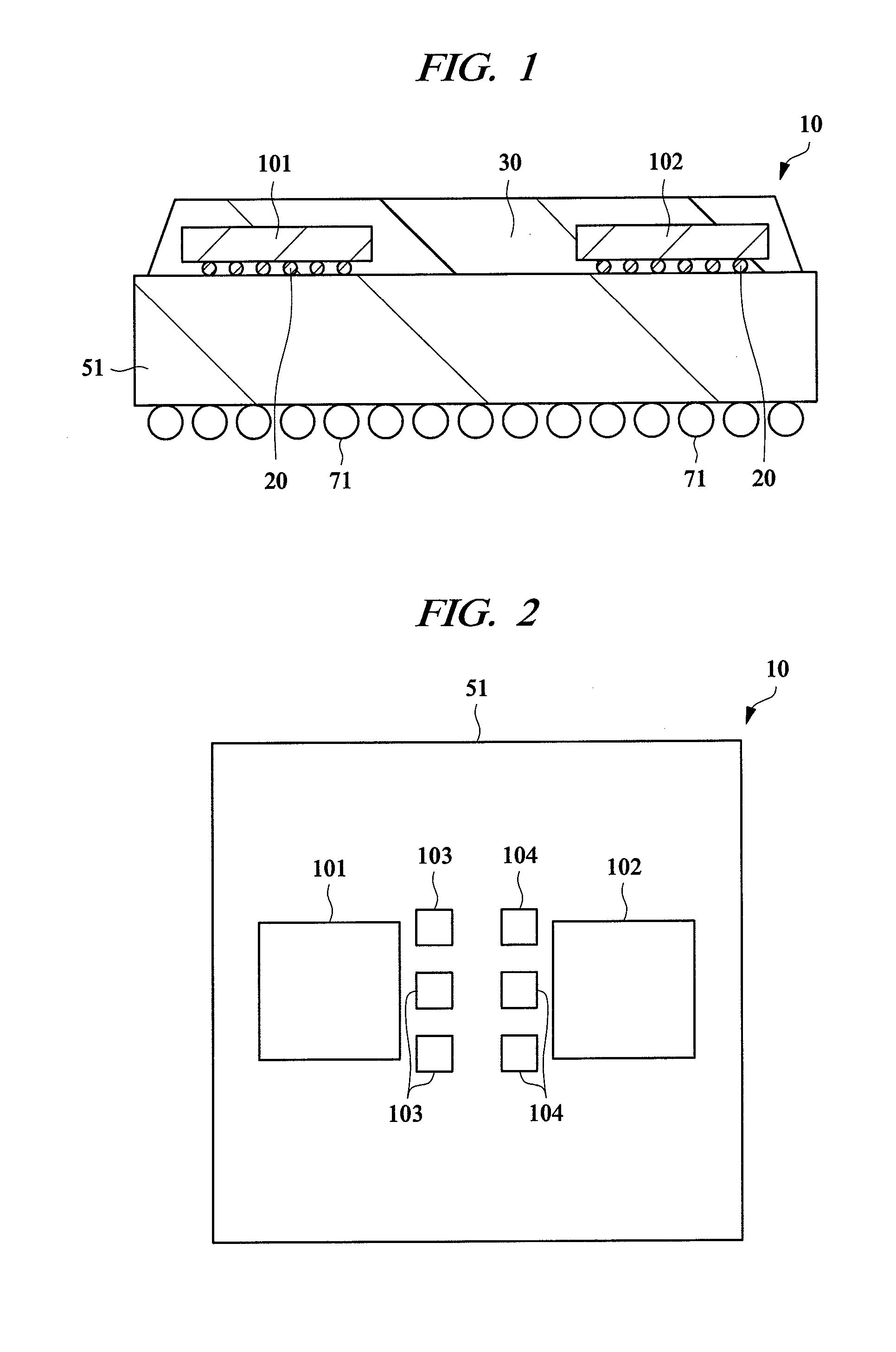Semiconductor device
a technology of semiconductor elements and semiconductor components, applied in the field of semiconductor devices, can solve the problems of difficult to constitute a power source for the digital semiconductor element, difficult to analog semiconductor elements, and low noise band required by analog rf signals
- Summary
- Abstract
- Description
- Claims
- Application Information
AI Technical Summary
Benefits of technology
Problems solved by technology
Method used
Image
Examples
first embodiment
[0060]FIG. 1 is a cross-sectional diagram showing one example of a structure of a semiconductor device according to a first embodiment of the present invention, FIG. 2 is a plan diagram showing one example of a mounting layout of parts in the semiconductor device shown in FIG. 1, and FIG. 3 is a structural diagram showing one example of routing of inner wire over a package board of the semiconductor device shown in FIG. 1. And, FIG. 4 is a plan diagram showing one example of a structure of a power layer for an analog element and a power layer for a digital element provided over the package board of the semiconductor device shown in FIG. 1, FIG. 5 is a plan diagram showing one example of a structure of a ground layer provided over the package board of the semiconductor device shown in FIG. 1, FIG. 6 is a plan diagram showing one example of a structure of an EBG layer provided over the package board of the semiconductor device shown in FIG. 1, and FIG. 7 is a back diagram showing one ...
second embodiment
[0092]FIG. 12 is a structural diagram showing one example of routing of inner wire in a package board of a semiconductor device according to a second embodiment of the present invention.
[0093] In a SIP (semiconductor device) 10 according to the second embodiment, the power layer for digital 54D is arranged on a side near a back face of the package board 51. That is, the power layer for digital 54D is disposed between the EBG layer 52 and the solder balls 71. Thereby, in a layer including a wiring layer of the power layer for digital 54D, wires for digital signal can be formed in a region corresponding to a portion just below the power layer for analog 54A, so that a wire use rate can be improved.
[0094] Note that, since the power layer for digital 54D is arranged on a side near the back face of the package board 51, the power layer for digital 54D can be connected to the solder balls 71 with a shortest route by shortening the digital power source connection viaholes 64. Thereby, co...
third embodiment
[0097]FIG. 13 is a structural diagram showing one example of routing of inner wire in a package board of a semiconductor device according to a third embodiment of the present invention.
[0098]FIG. 13 is a diagram showing respective signal wires of the analog chip 101 and the digital chip 102 in the SIP (semiconductor device) 10 according to the third embodiment. Signal area for analog (signal area for analog element) 55A is wired adjacent to the power layer for analog 54A or the ground layer 53 to connect the analog chip 101 and the solder balls 71 to each other. For example, the signal area for analog 55A is disposed between the analog chip 101 and the power layer for analog 54A along the power layer for analog 54A and connects signal connection terminals for analog 23A that are signal connection terminals for the analog chip 101 and the solder balls 71 for analog signal.
[0099] By disposing the signal area for analog 55A adjacent to the power layer for analog 54A or the ground lay...
PUM
 Login to View More
Login to View More Abstract
Description
Claims
Application Information
 Login to View More
Login to View More - R&D
- Intellectual Property
- Life Sciences
- Materials
- Tech Scout
- Unparalleled Data Quality
- Higher Quality Content
- 60% Fewer Hallucinations
Browse by: Latest US Patents, China's latest patents, Technical Efficacy Thesaurus, Application Domain, Technology Topic, Popular Technical Reports.
© 2025 PatSnap. All rights reserved.Legal|Privacy policy|Modern Slavery Act Transparency Statement|Sitemap|About US| Contact US: help@patsnap.com



